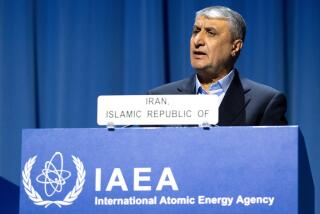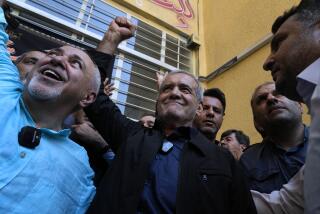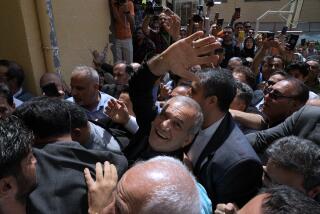Iran arrests demographers, the latest target amid an escalating crackdown on academics and activists
Reporting from Tehran — Academics with foreign ties living in Iran are on alert following the arrest of a demographer whose research led her to question the country’s decision to urge people to have more children.
Meimanat Hosseini-Chavoshi, who is a citizen of both Iran and Australia, was arrested in November while she tried to leave and is accused of being a spy, according to Kayhan, Iran’s conservative newspaper.
Her colleague, Mohammad Jalal Abbasi-Shavazi, a demographics professor at Tehran University and director of Iran’s National Institute of Population Research, was detained shortly after by Iran’s Islamic Revolutionary Guard and interrogated about his work on population growth and fertility, the semiofficial Fars News Agency reported.
Authorities allege that the two demographers falsified statistics about the fertility rate in Iran to mask the country’s “population crisis,” Iranian state media have reported. The government contends there is a coming population shortage and has been pushing to increase the fertility rate.
The arrest of a university researcher for simply engaging in academic inquiry is unusual even in a country with a long history of jailing activists and has renewed fear among other scholars and researchers who live and work in Iran.
“It’s a signal to people in the country to be careful, or you will end up in jail,” said Siavash Ramesh, a political analyst in Iran. “If a demographer who says the population is good enough, is jailed, then who is safe?”
Shortly after the 1979 revolution, during the early years of the Islamic Republic, the government embarked on a systematic crackdown on people it viewed as enemies of the conservative theocracy. Sporadic crackdowns have followed over the decades.
The recent arrests of activists, lawyers, environmentalists, women’s rights activists and now academics, a handful of whom hold dual citizenship, signal an escalating attack on civil society.
The arrest of the demographers reflects a shift in tactics by hard-liners against those they believe are “foreign agents” working against the policies of Ayatollah Ali Khamenei, Iran’s supreme leader.
“Iranian security forces are beginning to close the space for both activism and analytical inquiry,” said Suzanne Maloney, an Iran specialist at the Brookings Institution.
The latest wave of repression started on Dec. 28, 2017, when hundreds of Iranians were arrested and at least 20 killed after protesters took to the streets demanding the resignations of Iran’s top leaders.
A month later, in February 2018, authorities began arresting environmentalists.
Kavous Seyed Emami, a sociology professor with Canadian citizenship, was one of eight environmental activists arrested and accused of passing intelligence to foreigners. The government said he hanged himself in Tehran’s Evin Prison, though his family has challenged that account.
A handful of academics, including Iranians who hold dual citizenship, have also been arrested in recent years and remain in prison.
Xiyue Wang, a Princeton University academic and American citizen who was conducting research on the Qajar dynasty in Iran, was sentenced to 10 years in prison in 2017 on spying charges. Iranian-Swedish scientist Ahmadreza Djalali was sentenced to death a few months later on espionage charges.
Hosseini-Chavoshi worked with the Australian National University as a researcher and coauthored “Population Developments in Iran,” a book detailing population trends in Iran and their effect on the country’s economy. She and other experts believe that Iran can’t sustain a large population increase.
The allegations against her suggest how Iranian’s preference for smaller families has become a politically sensitive topic and stoked the fears of some religious conservatives about the future of the Islamic Republic.
After the 1979 Islamic Revolution, officials encouraged people to have large families. The population doubled in almost a decade to 55 million, up from 27 million in 1968, according to data from the United Nations.
But after the Iran-Iraq war, officials reversed their policy. Contraceptives became widely available and religious leaders encouraged women to wait before getting pregnant. By the 1990s Iran had one of the most effective population control policies in the world.
Today, that policy has placed Iran in a precarious situation: As Iran’s working-class population continues to grow older, the country’s outdated and poorly designed public pension programs could become strained.
Consequently, Khamenei has been calling for people to have more babies and has said he wants the population to grow from 80 million to 150 million people.
Hard-liners rallying behind the supreme leader are accusing critics such as Hosseini-Chavoshi of being part of a Western conspiracy to keep Iran weak.
Nasrullah Pezhmanfar, a cleric and member of Iran’s cultural committee of parliament, said reducing the number of people in Iran is an act of war initiated by America and its allies. “The enemy has been implementing a consistent plan to reduce the birthrate,” he said on state-run TV.
Still, Iranians’ preference for having fewer children is likely to stay around.
Mehdi Akbari, 32, has been married for three years. He repairs cellphones at a shop in Valiasr Square.
Although he’d like to have children, Akbari said he can’t to afford to raise them in Iran’s fickle economy. He makes about $250 a month and said he is barely able to make ends meet.
“My mom keeps saying that I must start a family, but I am not sure I can even afford a decent education or quality of life for my child,” he said. “No way, we cannot afford to start a family.”
Special correspondent Mostaghim reported from Tehran and Times staff writer Melissa Etehad from Los Angeles
Follow me on Twitter @melissaetehad
More to Read
Sign up for Essential California
The most important California stories and recommendations in your inbox every morning.
You may occasionally receive promotional content from the Los Angeles Times.











